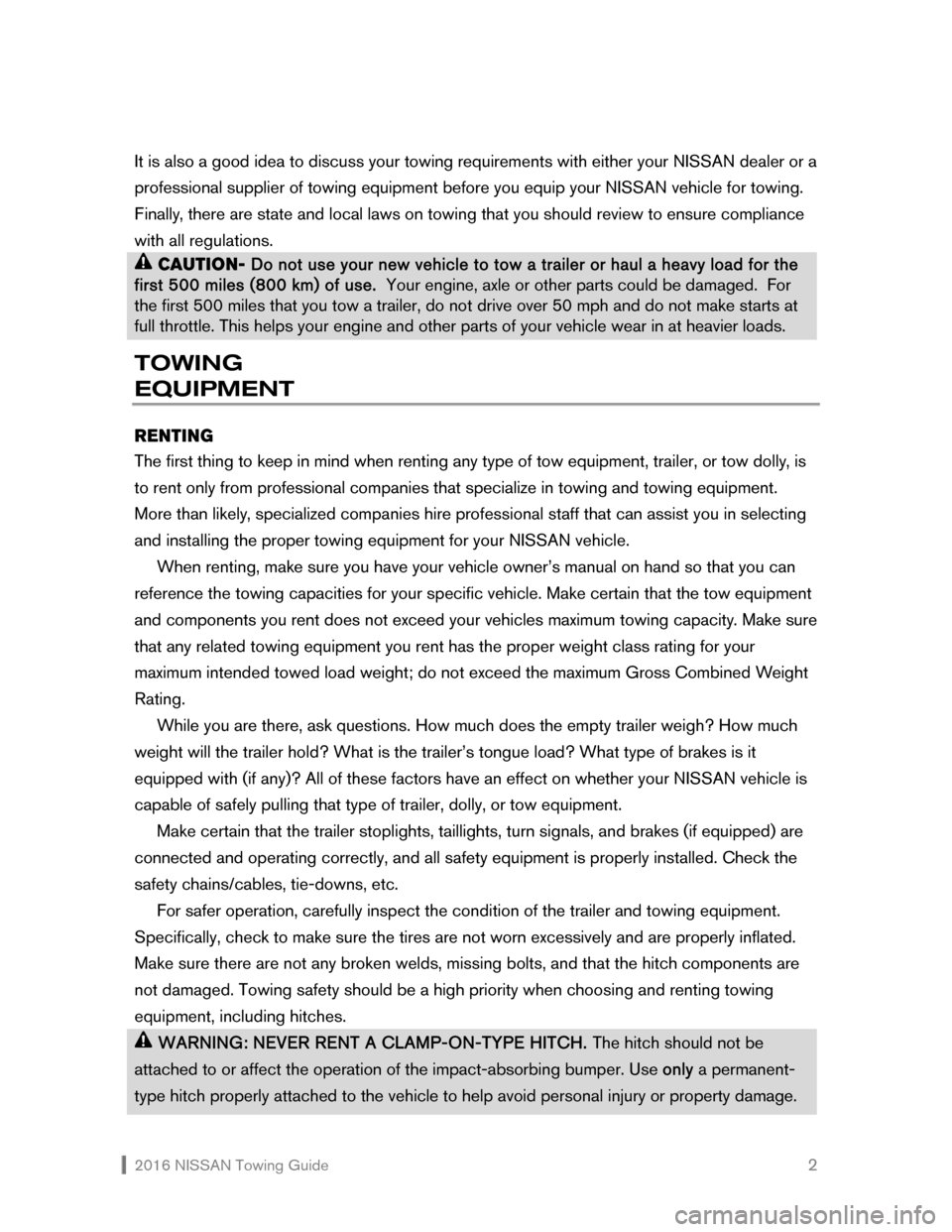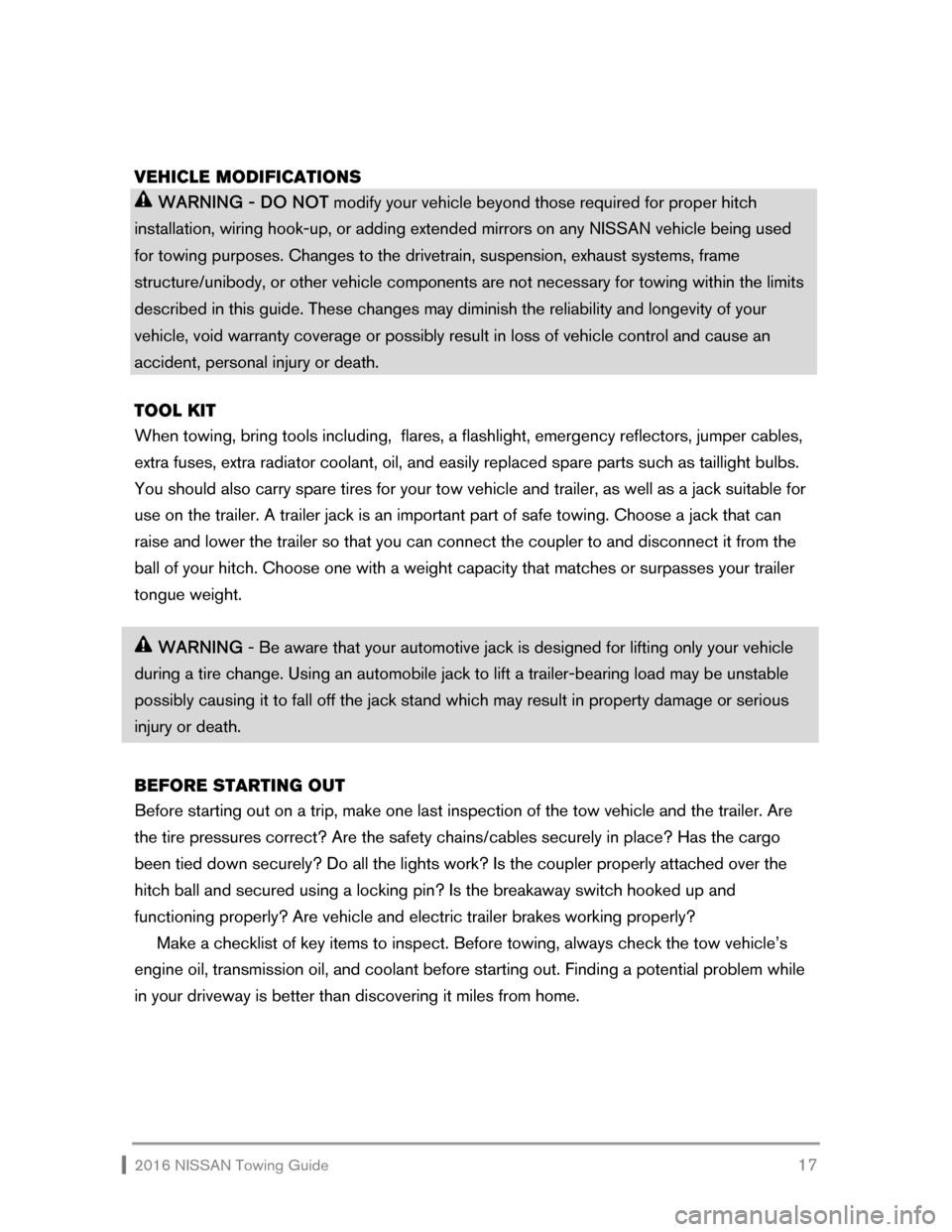tires NISSAN QUEST 2016 RE52 / 4.G Towing Guide
[x] Cancel search | Manufacturer: NISSAN, Model Year: 2016, Model line: QUEST, Model: NISSAN QUEST 2016 RE52 / 4.GPages: 27, PDF Size: 0.55 MB
Page 2 of 27

2016 NISSAN Towing Guide 1
INTRODUCTION
SAFETY IS PRIORITY ONE
Obviously, your first concern should be safety. Your vehicle was designed to be used primarily
to carry passengers and cargo. Always remember that towing a trailer places additional loads
on your vehicle’s engine, drivetrain, suspension, and steering, braking, and other systems.
Therefore, be certain that your vehicle can meet the demands of the towing application you
have in mind.
Rent or purchase towing equipment that complies with established industry standards and
state and federal safety regulations. Reinforced tow hitches designed especially for certain
NISSAN vehicles are available from your NISSAN dealer. Hitches for other NISSAN models –
if Nissan recommends towing with that vehicle - should be bought from and installed by a
professional supplier of towing equipment. Carefully review all information and literature
provided with any hitch you purchase for safety and proper use information.
Finally, it is important to follow the towing capacity limit set for your specific vehicle, and to
ensure that your vehicle is in top mechanical condition, especially the tires, brakes,
suspension, and engine cooling system. See your vehicle owner’s manual for details.
WHAT IS THE ESTABLISHED TOWING CAPACITY FOR YOUR VEHICLE
Towing capacities vary from vehicle to vehicle. See the towing information in your vehicle
owner’s manual to confirm whether your NISSAN vehicle can be used to tow and if so, what
its towing capacity rating is. Use this data to help select the proper NISSAN vehicle to meet
your anticipated towing needs, and refer to it when renting a trailer or other piece of towing
equipment.
EQUIP YOUR NISSAN FOR TOWING
The frequency and type of towing dictate the manner in which you equip your vehicle. If you
plan to tow often, for either recreation or work, select the engine size, transmission type,
suspension, and towing capacity that are best suited to your requirements. This guide can
help you select that equipment.
If, on the other hand, your towing will be infrequent, choose the NISSAN vehicle and
equipment that best meets your day-to-day needs. Be careful not to exceed the towing
capacity on those few occasions when you do tow.
READ THIS GUIDE BEFORE YOU TOW
This guide was designed to provide an overview of safe towing practices. Here, you will find
information on towing equipment, safety, proper loading and driving techniques, towing tips,
and much more.
Page 3 of 27

2016 NISSAN Towing Guide 2
It is also a good idea to discuss your towing requirements with either your NISSAN dealer or a
professional supplier of towing equipment before you equip your NISSAN vehicle for towing.
Finally, there are state and local laws on towing that you should review to ensure compliance
with all regulations.
CAUTION- Do not use your new vehicle to tow a trailer or haul a heavy load for the
first 500 miles (800 km) of use. Your engine, axle or other parts could be damaged. For
the first 500 miles that you tow a trailer, do not drive over 50 mph and do not make starts at
full throttle. This helps your engine and other parts of your vehicle wear in at heavier loads.
TOWING
EQUIPMENT
RENTING
The first thing to keep in mind when renting any type of tow equipment, trailer, or tow dolly, is
to rent only from professional companies that specialize in towing and towing equipment.
More than likely, specialized companies hire professional staff that can assist you in selecting
and installing the proper towing equipment for your NISSAN vehicle.
When renting, make sure you have your vehicle owner’s manual on hand so that you can
reference the towing capacities for your specific vehicle. Make certain that the tow equipment
and components you rent does not exceed your vehicles maximum towing capacity. Make sure
that any related towing equipment you rent has the proper weight class rating for your
maximum intended towed load weight; do not exceed the maximum Gross Combined Weight
Rating.
While you are there, ask questions. How much does the empty trailer weigh? How much
weight will the trailer hold? What is the trailer’s tongue load? What type of brakes is it
equipped with (if any)? All of these factors have an effect on whether your NISSAN vehicle is
capable of safely pulling that type of trailer, dolly, or tow equipment.
Make certain that the trailer stoplights, taillights, turn signals, and brakes (if equipped) are
connected and operating correctly, and all safety equipment is properly installed. Check the
safety chains/cables, tie-downs, etc.
For safer operation, carefully inspect the condition of the trailer and towing equipment.
Specifically, check to make sure the tires are not worn excessively and are properly inflated.
Make sure there are not any broken welds, missing bolts, and that the hitch components are
not damaged. Towing safety should be a high priority when choosing and renting towing
equipment, including hitches.
WARNING: NEVER RENT A CLAMP-ON-TYPE HITCH. The hitch should not be
attached to or affect the operation of the impact-absorbing bumper. Use only a permanent-
type hitch properly attached to the vehicle to help avoid personal injury or property damage.
Page 5 of 27

2016 NISSAN Towing Guide 4
● Installing an aftermarket hitch may affect the rear crash performance of your vehicle.
Changing the crash performance of a vehicle could lead to more severe vehicle damage,
personal injury or death in a crash. Be sure that the hitch does not interfere in any way with
the vehicle’s impact-absorbing bumper.
● Never attach a hitch or towing device to the vehicle bumper. This may affect the
operation of the impact-absorbing bumper. Use only a permanent-type hitch properly
attached to the vehicle to help avoid personal injury or property damage.
● Regularly check to see that all hitch-mounting bolts are securely fastened to ensure
the hitch will not come loose, and remains properly attached to the vehicle to help
avoid property damage, personal injury or death.
CAUTION -For receiver-type hitches using a ball mount, the ball mount should be
removed when not towing, or by protecting it with a special cover, this will help protect it from
damage, and prevent rust from forming on it.
● If you install a hitch yourself, remember that it must be securely attached to the frame or
underbody, according to the manufacturer’s instructions. Never attach a hitch or towing
device to the vehicle axle housing. This may damage the housing, wheel bearings,
wheels, or tires.
Hitch Types
Bumper Hitch – This is a special reinforced
bumper designed to accommodate a
standard trailer hitch ball. The light-duty
bumper hitch must support the trailer
tongue weight all by itself. Fixed ball mount
hitches are limited to 1,000 lbs. and 100 lbs.
of tongue weight normally used for light-duty
towing.
Receiver Hitch – A receiver hitch is bolted
directly to the vehicle structure for added
strength and durability. NISSAN bolt-on
receiver hitches are designed for use with
NISSAN vehicles, and include the
necessary reinforcements, with ample
clearance around bumpers, and frame
members, etc. These hitches allow for the
removal of the ball mount when not towing.
Page 6 of 27

2016 NISSAN Towing Guide 5
Weight-Distributing Hitch System – This
type of system uses a “load-leveling” or
“equalizing” hitch. The weight-distributing
feature helps shift trailer tongue weight to
all axles of the tow vehicle and all trailer
tires.
For Armada, Frontier, Pathfinder, Titan,
and Nissan NV vehicles, a weight-
distributing hitch ball mount (Class IV) is
recommended if you plan to tow trailers with a maximum weight over 5,000 lbs. This ball
mount includes a 2
5/16” hitch ball and is available through your NISSAN dealer.
NOTE – A weight-distributing hitch system may affect the operation of trailer surge brakes. If
you are considering use of a weight-distributing hitch system with a surge brake-equipped
trailer, check with the surge brake, hitch, or trailer manufacturer to determine if and how this
can be done. Follow the instructions provided by the equipment manufacturer for installing
and using the weight-distributing hitch system.
Clamp-On Bumper Hitch – This temporary
hitch clamps onto the bumper assembly.
WARNING-DO NOT USE a clamp-on
bumper hitch on any NISSAN vehicle
because using it may result in the trailer
separating from the towing vehicle. If the
trailer separates from the vehicle, it could
cause a crash, resulting in property damage
and personal injury, or death. Use of this type
of hitch can also damage the towing vehicle.
Page 13 of 27

2016 NISSAN Towing Guide 12
On all NISSAN vehicles, the GVWR is shown on the
Federal Motor Vehicle Safety Standard (F.M.V.S.S.)
certification label located in the driver’s-side door area.
Weigh your vehicle on the scale with all of the
passengers and cargo that are normally in the vehicle
when pulling a trailer. Subtract the actual vehicle
weight from the GVWR. The remaining amount is the
available maximum tongue/king pin load.
To avoid overloading the vehicle, be sure
to include the trailer tongue/king pin load as a
part of the cargo when determining how much weight
can be safely carried inside the vehicle.
GROSS AXLE WEIGHT (GAW)
The Gross Axle Weight (GAW) is the maximum weight placed on a single axle (front and rear)
that it is designed to safely carry.
To determine the GAW, load the vehicle as you would for towing and attach the loaded
trailer. At a public scale, with the loaded trailer attached, place only the tow vehicle's front
wheels on the scale to determine the actual front axle GAW. To obtain the rear axle GAW,
place all four tow vehicle's wheels on the scale. From that figure, subtract the front GAW and
you will have the rear GAW amount. The cargo in the trailer and the vehicle may have to be
distributed, or some removed to meet the specified rating.
The GAW you come up with must not exceed the Gross Axle Weight Rating (GAWR)
for your vehicle. On NISSAN vehicles, the GAWR for both axles is listed on the F.M.V.S.S.
certification label.
MFD BY NISSAN MOTOR CO., LTD
DATE
GVWR
GAWR FR.
WITH
GAWR RR.
WITH
THIS VEHICLE CONFORMS TO
ALL APPLICABLE FEDERAL
MOTOR VEHICLE SAFETY
STANDARDS IN EFFECT ON
THE DATE OF MANUFACTURE
SHOWN ABOVE.
SEE OWNERS MANUAL FOR
ADDITIONAL INFORMATION.
TIRES
TIRES
TYPE: TRUCK
MODEL: 3B000
COLOR TRIM TRANS
AXLE ENGINE
RIMS AT PSI
COLD SINGLERIMS AT PSI
COLD SINGLE
F.M.V.S.S.
Certification Label
Page 17 of 27

2016 NISSAN Towing Guide 16
WARNING -The trailer load should be
balanced equally from side-to-side. Unequal side-
to-side loading can negatively affect handling and
braking. Once in place, all cargo should be firmly
secured to prevent shifting. If the load should shift
abruptly during braking or cornering, it could
quickly affect the handling of your vehicle and
cause a very unsafe situation, loss of control or
serious accident or death.
● Do not carry flammable materials, such as
gasoline, in your trailer. In the event of an accident,
an explosion or fire could occur, causing personal
injury or death.
PROVIDING FOR VEHICLE/TRAILER STABILITY
WARNING - Improper loading, excessive or insufficient trailer tongue/king pin load,
overloading, excessive trailer weight, poorly designed trailer suspensions, crosswinds, and
poor maintenance are all things that can affect the stability of your vehicle and trailer
combination. Vehicle instability may result in loss of vehicle control and cause an accident,
personal injury or death.
If swaying does occur, check the cargo load for proper balance and distribution to ensure
proper trailer tongue/king pin load. In addition, check the condition of the suspension and
shocks, as well as the tires, tire pressures, and wheel bearings on both the tow vehicle and
the trailer. If the swaying continues and your trailer is suitably balanced and within the towing
capacity limits of your vehicle, discontinue towing and consult your NISSAN dealer or trailer
manufacturer to determine the cause.
VEHICLE SPEED
Please note that some states have specific regulations and speed limits for vehicles that are
towing trailers. Remember to reduce your speed in unsafe or less-than-ideal road conditions
or weather. When towing a trailer, braking distances increase while handling agility decreases.
Always leave yourself an extra margin of distance to respond to emergencies.
PASSENGERS
WARNING- Never allow passengers to ride inside a trailer while it is being towed
because there
are not any passenger restraints in a trailer. Not only is this unlawful in
most areas, passengers could be seriously injured or killed during sudden trailer movement or
in an accident. In addition, trailers may allow fumes from the tow vehicle to leak inside. This
could result in carbon monoxide poisoning from the engine exhaust.
Page 18 of 27

2016 NISSAN Towing Guide 17
VEHICLE MODIFICATIONS
WARNING - DO NOT modify your vehicle beyond those required for proper hitch
installation, wiring hook-up, or adding extended mirrors on any NISSAN vehicle being used
for towing purposes. Changes to the drivetrain, suspension, exhaust systems, frame
structure/unibody, or other vehicle components are not necessary for towing within the limits
described in this guide. These changes may diminish the reliability and longevity of your
vehicle, void warranty coverage or possibly result in loss of vehicle control and cause an
accident, personal injury or death.
TOOL KIT
When towing, bring tools including, flares, a flashlight, emergency reflectors, jumper cables,
extra fuses, extra radiator coolant, oil, and easily replaced spare parts such as taillight bulbs.
You should also carry spare tires for your tow vehicle and trailer, as well as a jack suitable for
use on the trailer. A trailer jack is an important part of safe towing. Choose a jack that can
raise and lower the trailer so that you can connect the coupler to and disconnect it from the
ball of your hitch. Choose one with a weight capacity that matches or surpasses your trailer
tongue weight.
WARNING - Be aware that your automotive jack is designed for lifting only your vehicle
during a tire change. Using an automobile jack to lift a trailer-bearing load may be unstable
possibly causing it to fall off the jack stand which may result in property damage or serious
injury or death.
BEFORE STARTING OUT
Before starting out on a trip, make one last inspection of the tow vehicle and the trailer. Are
the tire pressures correct? Are the safety chains/cables securely in place? Has the cargo
been tied down securely? Do all the lights work? Is the coupler properly attached over the
hitch ball and secured using a locking pin? Is the breakaway switch hooked up and
functioning properly? Are vehicle and electric trailer brakes working properly?
Make a checklist of key items to inspect. Before towing, always check the tow vehicle’s
engine oil, transmission oil, and coolant before starting out. Finding a potential problem while
in your driveway is better than discovering it miles from home.
Page 24 of 27

2016 NISSAN Towing Guide 23
GROSS COMBINED
WEIGHT RATING (GCWR) The maximum allowable combined weight of the vehicle and trailer,
including passengers and all cargo.
GROSS VEHICLE
WEIGHT RATING (GVWR) The maximum allowable weight of the vehicle, including passengers, cargo,
fuel, hitch, trailer tongue load, and any optional equipment.
KING PIN
LOAD The amount of trailer (5th wheel or gooseneck) weight pressing down on the
tow vehicle hitch.
HITCH BALL
A ball that connects the trailer to the tow vehicle hitch that provides the
means by which the trailer pivots during cornering. Available in a number
of sizes and weight capacities, it must correspond to the trailer coupler
size, and have a sufficient capacity rating for the trailer being pulled.
RECEIVER HITCH A frame- or structure-mounted hitch with a receiver that allows removal of
the ball mount.
SAFETY CHAINS/CABLES Provides an emergency connection between the tow vehicle and the trailer,
should the trailer become disengaged for any reason.
SURGE BRAKES
Hydraulic-type braking system activated by inertia. As the tow vehicle
begins to brake, the trailer pushes against the hitch ball, consequently
activating the trailer brakes.
TRAILER TONGUE/COUPLER The part of the trailer that extends forward to meet the tow vehicle, and
carries the coupler assembly.
TRAILER TONGUE
LOAD The amount of trailer (conventional) weight pressing down on the tow
vehicle hitch.
WEIGHT-DISTRIBUTING
HITCH SYSTEM Type of hitch system that helps shift the trailer tongue weight to all trailer
tires and the tow vehicle front tires. Strongly recommended when towing
trailers with a Maximum Trailer Weight greater than 5,000 lbs.
WIRING HARNESS Provides an electrical connection linking the tow vehicle’s electrical system
to the trailer’s system.